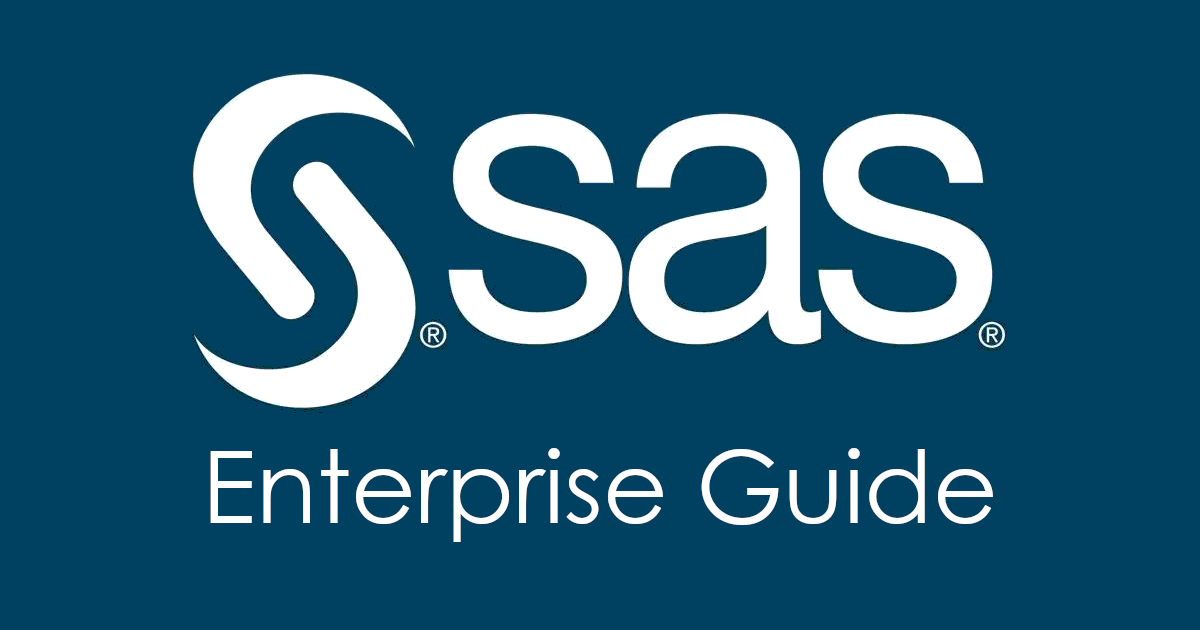What is SAS Enterprise Guide?
SAS Enterprise Guide is a statistical analysis program developed by SAS Institute. Although it can perform analysis on any data, the program is designed primarily to serve business users. As such, most of its advanced tools are focused on things like risk management, customer intent prediction, and marketing analysis. SAS Enterprise Guide can import data from any source, like an Excel table or a simple text file. Once imported, a variety of tasks can be performed on this data, ranging from simple ones like sorting and filtering, to more advanced ones like finding correlations, performing calculations, and building linear models. Once analysis is complete, the program can generate a visualization of the data or create a text-based report. The best part about SAS Enterprise Guide is that none of these tasks have to be done manually. By creating a process flow, the program can be instructed to automatically import the data, perform all necessary operations on it, and create a report containing the result of these calculations. Once a process flow is created, the whole process can be performed with a single click. SAS Enterprise Guide runs only on Windows operating system. However, third-party solutions can be used to run SAS Enterprise Guide on Mac as well. Read the article below for an overview.
Why doesn’t SAS Enterprise Guide run on Mac?
There are several reasons why some apps don’t run on Mac. It could be an incompatibility with Mac hardware or macOS version. Also, macOS Catalina and Big Sur don’t support 32-bit apps. Most developers are designing new, 64-bit versions of the apps, but there are still hundreds of apps that can only run on 32-bit Macs. In our case, the reason is that SAS Enterprise Guide native Macintosh version simply doesn’t exist. At the present moment, there is no information about the release date and the possibility that SAS Enterprise Guide will be available for Mac.
How to run SAS Enterprise Guide on Mac
The most popular solution for running SAS Enterprise Guide on Mac/MacBook is virtualization software. Despite the fact that emulators usually demand quite a lot of computing power out of a Mac, some of them, for example, Parallels, VirtualBox, or VMWare, can be used to run different programs on OS X with minimal losses in performance. Moreover, some of them are compatible with DirectX 11, which can help with running graphically demanding apps and games. They also allow you to copy any files between your Windows installation and OS X freely.
Running SAS Enterprise Guide through Parallels

Parallels Desktop is easily the best virtualization program available on Mac; as such, it is the best way to run SAS Enterprise Guide on Mac. It allows you to install Windows 10 on Mac with just a couple of clicks and switch between OS X and Windows instantly. So you will be able to run Windows and install SAS Enterprise Guide just like on a regular PC.
Running SAS Enterprise Guide through other virtual machines
Another popular virtualization program is VMware Fusion. It is a software hypervisor that allows running virtual machines like guest operating systems, such as Windows, Linux, FreeBSD, and Solaris. Fusion’s current versions provide hardware-accelerated DirectX 11 and OpenGL 4.1 capabilities to virtual machines, which allows them to run heavy, GPU-intensive applications and games with top 3D graphics.
You can also try VirtualBox, Wine, and QEMU, however, these solutions are not user-oriented and may require advanced computer skills.
Running SAS Enterprise Guide on remote server
If you have a powerful Windows-based server and a fast internet connection, another method is SAS Enterprise Guide running on Windows on a Server machine (in the cloud, or remote desktop) and looking at the screen from your Mac. You can use TeamViewer, AnyDesk, or other software for this purpose.
Running SAS Enterprise Guide on Windows 10 using Boot Camp
Note: Mac M1 chipsets are not supported by BootCamp
BootCamp allows users to choose the system to work in on startup, however, you won’t be able to switch between systems like in Parallels. Do note that you will need no less than 64 GB of free space on your device (we recommend having 128 GB). After Windows installation completes, your Mac starts up in Windows and opens a ”Welcome to the Boot Camp installer” Window. You will need to reboot your machine every time you want to switch from Mac to Windows and vice versa. To set up Windows via BootCamp, please, do the following:
For OS X El Capitan 10.11 and older
Important: for MacOS versions prior to OS X El Capitan 10.11 you will need to create bootable Windows USB.
- Download Windows ISO file
- Open Boot Camp Assistant (Go to Applications > Utilities)
- Define the Windows partition size choose downloaded Windows ISO file
- Format Windows partition and go through all Windows installation steps
- When Windows boots for the first time follow on-screen instructions to install Boot Camp and Windows support software (drivers)






